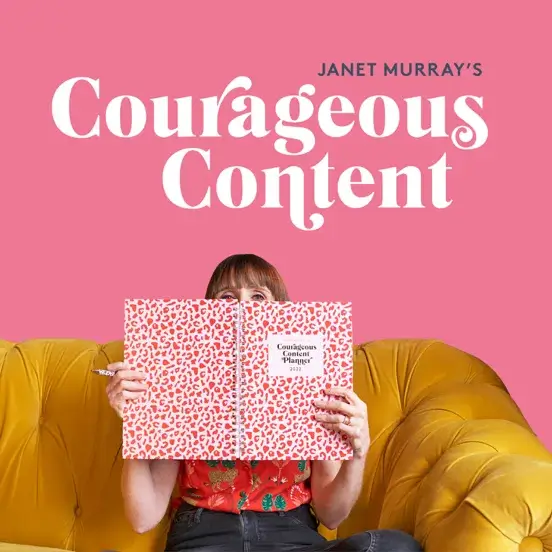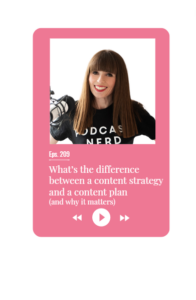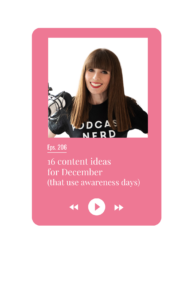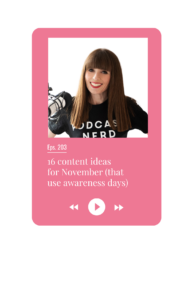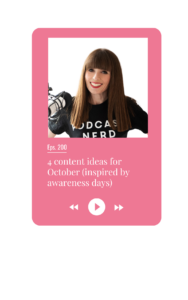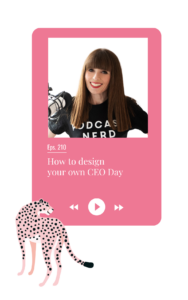
How to grow your audience through podcasting (even if you don’t have one!)
January 17, 2023
You don’t have to have a podcast to grow your audience through podcasting.

Podcasting is a great way to build your audience (and attract your ideal customer/clients).
And here’s the best thing…you don’t even have to have your own podcast.
In this episode of the Courageous Content Podcast, I’ll share how to grow your audience through podcasting – even if you don’t have a podcast.
Here’s what I cover:
– How I launched a top ranking podcast (with no experience)
– Why you don’t need fancy tech to launch a podcast
– Easy ways to get started with podcasting
– How to grow your audience through podcasting (even if you don’t have one)
When I published my first podcast, back in 2015, I had no experience whatsoever.
But I enjoyed listening to podcasts and thought it was a great way to connect with my ideal customers/clients (and build my audience).
If you’d told me my show would make the iTunes all-time best sellers for marketing and consistently the Top 100 UK business podcasts, I don’t think I’d have believed it.
I ended up publishing more than 450 episodes of my first podcast – Soulful PR – which I later changed to the Janet Murray Show and then Build Your Audience.
I recorded the first 373 episodes on my trusty Blue Snowball mic. I got a fancy Rode one for Christmas but I left it in the box for a year (as I loved my Blue Snowball so much).
In 2019, I wound up that podcast and launched a new one – Courageous Content. I now also have 12 private podcasts (I deliver all the training for my digital products via private podcast using Captivate).
How I launched a top ranking podcast (with no experience)
Interestingly though, I don’t really see myself as a podcaster. I don’t worry too much about my voice or even the tech I use (bar ensuring a high standard of audio quality). I mean I did worry at first – and when I listen back to my first podcast episodes – I do cringe a little…but the only way to get better at podcasting is to podcasting.
For me, podcasting is an enjoyable (and convenient) way to deliver my content. And while I’m a writer by trade (a former journalist), I find there’s just something so intimate about being in someone’s ear. Which means you can build a real connection with people.
And while I did create a top ranking podcast – I’m not really bothered about the numbers. Because what really matters is achieving your goals. And having 100 listeners who really engage with your content and/or take the action you want them to take (e.g. download your email lead magnet/buy your products/services) is better than millions who don’t. Case in point: one of my friends, Jessica Lorimer has made hundreds of thousands of pounds from her podcast Selling To Corporate – even though it has a much smaller audience than mine.
The most valuable lesson I’ve learned is that having a strategy i.e. being super clear about what you want to achieve from your podcast – not only makes it easier to achieve your goals…it can also save you a ton of time (and help you make every podcast you create work harder for you/your business). That strategy might change over time, as your business does – I changed the name of my first podcast three times – but that’s ok.
Why you need a podcast strategy
Taking the time to create your Podcast Strategy will also help you make key decisions on things like frequency: how often you should publish your podcast, format whether you should publish in seasons or have a ‘rolling’ podcast (i.e. publish every day, week, month or whatever) – a decision that again should be closely aligned to your podcast aims.
A key piece of advice I share with clients all the time – is start with a season. For example, one of my clients, Josephine Hughes, recently launched a podcast called Gloriously Unready – which is all about how to navigate change. And how to deal with the surprises life sometimes throws at you. Her first season is about finding out two of her three children are transgender – and her journey as a parent in dealing with that change.
As Josephine, a counsellor, hasn’t published a podcast before – or indeed very much content on this topic – it’s new territory for her. Which is why taking a broad theme for her podcast (dealing with emotions you feel unready for) – rather than creating a podcast specifically about transgender issues is smart.
Because it means she could come back with a second, third, or even full season on other types of life experiences you might feel unready for. Or do further seasons on the same topic, taking a different angle or approach or both. Some of my favourite podcasts: How to fail with Elizabeth Day and Changes with Annie McManus take this approach.
The other thing I’ve learned (which is true for All Things Marketing) is that you need to promote your podcast far more than you feel comfortable. Many podcasters publish an episode, post a few social media posts then move onto the next week. They don’t even promote the episodes in their archive.
But planning more strategically can also help you identify opportunities to re-use and repurpose your podcast content. So, for example, some business owners republish their most popular podcast episodes in December. Or when they’re taking a break over the summer. Or create ‘round up’ episodes that feature their most popular episodes (which may require some additional planning/recording). Getting these on the calendar, ahead of time, can save you time in the long run – something we’ll talk more about in an upcoming session.
It can also help you see opportunities to promote episodes from your archive – something many podcasters don’t do enough of. For example, we promote several episodes from my ‘back catalogue’ every week – to coincide with relevant awareness days e.g. I recently republished an episode on trolling to coincide with Anti Bullying Week.
Thinking more strategically can also help you repurpose other content you’re creating in your business. For example, in 2022 I worked with Kay Fabella – a Fully Booked DEI consultant – we started out creating her podcast strategy, moved on to scripting episodes together. In November I wrote a whitepaper with Kay – over two Zoom sessions – which I repurposed into three podcast episodes (that included a CTA for her whitepaper) – and three social posts per episode.
Another thing I’ve learned is that doing things in the ‘right’ order i.e. your podcast workflow can save you a ton of time on content creation (and make each podcast work harder for you/your business). So I’ve created templates for myself that allow me to create a blog that I use as a script for my podcast. I then turn that blog into show notes. The show notes are created in such a way they can easily be repurposed into social media posts.
Achieving that kind of result for Kay was also about workflow. I created a template for her whitepaper that could easily be repurposed into three podcast episodes, then show notes, then social posts.
If you’re thinking of starting a podcast (or already have one) I’ve recently created a Courageous Podcasting Content Kit. There is a 60-minute audio training on podcast strategy (also available as an EBook). It also includes in the templates you need to grow your podcast. Including:
- Podcast Growth Strategy templates – so you have a roadmap to follow to grow your podcast
- Fill-in-the-gaps content templates for podcasts scripts/outlines, podcast trailers,
show notes, promotional emails, social media posts and guest interviews – so you can save time on content creation - Podcast repurposing strategy – so you can make every podcast episode you create work harder for your business
It also includes an Audience Growth Strategy – including templates for pitching yourself as a podcast guest and podcast swaps. This part of the training and kit is definitely worth a look – even if you’re not planning on launching a podcast – because you can use podcasting to grow your audience (even if you don’t have one). And if you’re thinking of launching a podcast, but are not sure…doing guest interviews is a great way to find your voice (as it were).
And if you can target podcasts that have the audiences you’re trying to reach it’s a great way to build your audience by, essentially, ‘borrowing’ someone else’s.
I go through this in more detail in the training in the Courageous Podcasting Content Kit, but the key thing is to think about how you can give (i.e. add value) rather than take). I get dozens of podcast pitches each week and I’ve said yes to about two – EVER – so that’s a lot that haven’t been successful over the 7 years I’ve been podcasting. And let’s say you did a podcast ‘tour’ where you got interviews on 25 podcasts with 2000 monthly downloads – that’s 50,000+ people.
The reason they are not successful is because they haven’t bothered to listen to my podcast and/or try to understand what I’m looking for. Which means their pitch is way ‘off’. Some even make stupid mistakes like pitching to my old podcast – even though the last episode is ‘why I’m ending this podcast’. It shows a real lack of respect for the platform someone has built.
Personally, I would never pitch a podcast host without studying the podcast – looking at the topics that have been covered previously and looking at previous guests. And listen to several episodes to get a feel for the podcast host and the style.
There are a few things I learned from my journalism days (as a freelance journalist/ editor) I both sent and received hundreds of pitches so I know what ‘works’ in terms of getting ‘airtime’ (or column inches). Using engaging email subject headers and getting to the point quickly in your pitch emails is vital – but not always obvious how to do it (if you haven’t done it before). So I’ve turned what I’ve learned into a template – which is included in the kit.
To get the most from a podcast tour… strategy is key. I’d recommend a very specific email lead magnet or resource – and using trackable URLs – so you can measure which podcasts are delivering the best results.
You May also like
